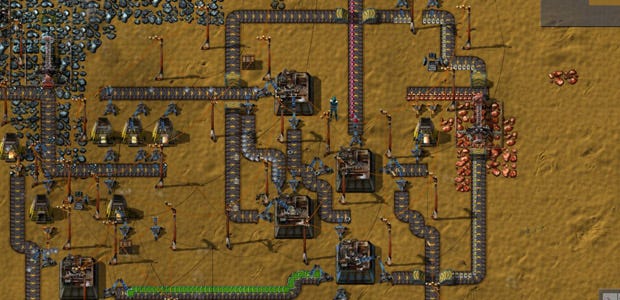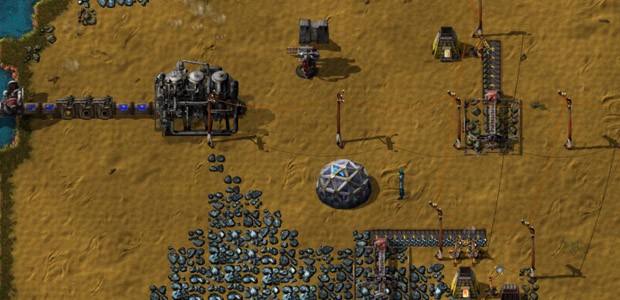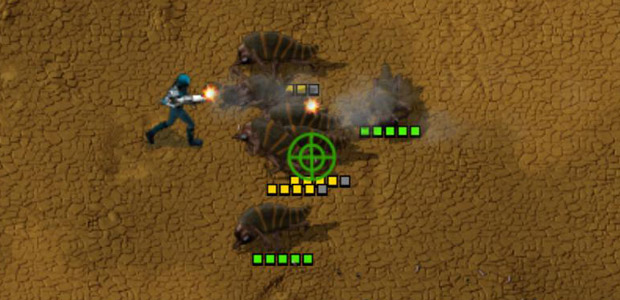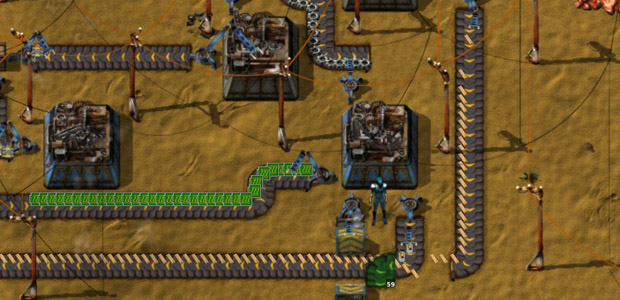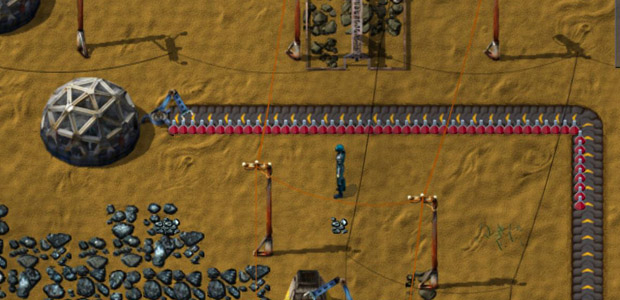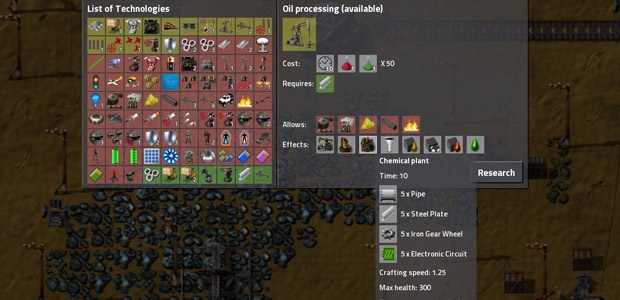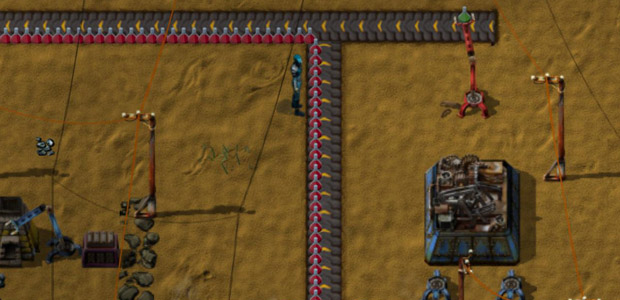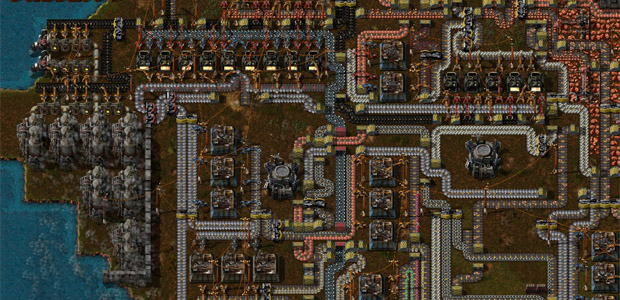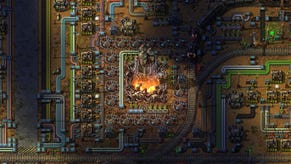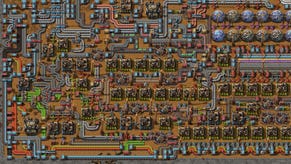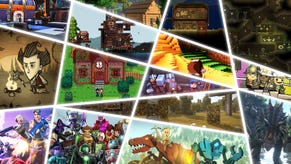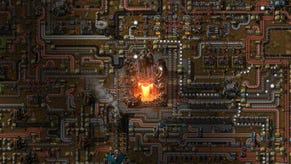The Lighthouse Customer: Factorio
Automation Vacation
Each Monday, Chris Livingston visits an early access game and reports back with stories about whatever he finds inside. This week, building efficient machines to make other efficient machines in strategy game Factorio.
I've got coal-powered drills digging up resources, mechanical arms collecting the raw materials, and conveyor belts transporting it across the landscape where more arms collect it and deposit it into fabrication machines, after which the resulting product is plucked out by still more arms, dropped on more belts, moved on to more factories. Clouds of pollution fill the air, production lines twist and turn haphazardly, electrical poles and storage units appear to have been placed by a confused and drunken city planner. It's a mess. A big mess. But it's a beautiful mess, because it all works.
Factorio has been in development since 2012, funded initially by Indiegogo and currently by alpha sales. It's a isometric management game that has a familiar-sounding premise: you've crashed on an alien planet and must harvest resources, research technology, and build machines. It immediately feels different, though, because so much of the game is focused on creating automation systems. You build machines, production lines, and factories to do your work for you. Unlike Minecraft, where the early game requires you to manually chip away at resources for ages before you're able to build anything of real use, in Factorio the automation begins almost immediately. There's still plenty of work to do, but most of the work involves building machines to do your work, and then building machines to build those machines.
Take my poor little marooned spaceman. He's been on the planet for just a short while. Yes, he dug up a few rocks by hand, and of course he's manually chopped down a few trees because Video Game Law now requires every game make you do that. But! He's already got a coal-powered drill digging up coal (though some of it is needed to feed the drill itself) and other drills digging up iron and copper. He's got a few stone ovens smelting the ore into plates, and mechanical arms both feeding the machines the raw materials and removing the resulting products.
A few minutes later he can sink a pump into a lake, suck the water into a series of coal-fired boilers, heat it into steam, and feed the steam into an engine to produce electricity, which is then run across the landscape by a series of poles to anything that needs power.
One the juice is loose, some real automation begins. Tired of collecting coal and carrying it to the boilers? Conveyor belts can move it to where you need it most, and a arm at each end means there's no need for you to ever pick up, put down, or even think about coal ever again. Of course, building those conveyor belts and mechanical arms is a bit of a chore, isn't it? Bring on the assemblers, little factories that can be fed components and produce finished goods, and even combine different finished goods into something else. Soon you'll have conveyor belt units running along conveyor belts and mechanical arms plucking freshly-built mechanical arms out of your mechanical arm factories. Raw resources are coming out of the ground and being fabricated into complicated machinery without you having to touch them once.
One issue with having a ton of machines and factories running night and day is that there's a bit of a pollution problem. As in SimCity games, too much pollution upsets the locals and causes them to leave their homes, though in SimCity they don't rush over in huge swarms and bite you to death. The native alien bugs, appropriately called Biters, are fast and angry and try to kill you and destroy your machines when your carbon footprint starts stinking up their burrows. They're not super easy to kill, even if you've crafted a submachine gun.
But wait! Why would you kill aliens yourself when you can slaughter them with yet another helpful machine? You can build turrets that will fire autonomously: just craft some magazines and stick them in, or better yet, craft some machines to craft some magazines and have a mechanical arm stick them in. Build some stone walls to protect your factories and turrets (or have an assembly line build your walls, preferably) and soon you won't even see the aliens, you'll just hear a distant, comforting roar as your robotic guns chew them into pulp somewhere offscreen. Nagging thought: I don't think you're the good guy in this game.
While it's been a bit hectic just keeping up with my machines, things slow way down when I get into research. In order to unlock new technology, or improvements to current tech, you need to build research labs. The labs run on something I'm sure has a proper name but which I call "science potions," little jugs of colored technology water that labs need a big supply of to conduct research. The lowest level of red science juice is made from base items, but is still very slow to craft in my inventory, and once a bottle is dumped into the lab, the research progress is pretty slow as well. I decide to occupy my time by having the potions assembled, delivered, and dumped without my interference.
This is a fun little challenge, made harder by the fact that I had no idea I'd need to do this and so my belts and arms and assemblers are all terribly placed for the task. Soon, though, I've got a wonky, awkward, winding assembly line of potions running right to my lab's front door. It immediately becomes backed up because the research itself is so irritatingly slow, but still! Look at my line of science wine! It's lovely, and I need never craft it by hand again.
New tech leads to better tech, and better tech requires Level 2 science water or "Science Dew" as I call it (it's green), which I'm also determined to produce automatically. The green potion requires several ingredients to make, and some of those ingredients require several ingredients of their own. This requires a whole lot more conveyor belts and assemblers, loaders and unloaders, and it's not long before my collection of factories is a complete mess, with belts crossing each other (you can build them underground) and electrical lines strewn everywhere. Still, despite the inefficiency, I manage to get machine-fabricated Science Dew onto the same production belt feeding the lab. Sure, there are a million red potions sitting there and a green only comes along every once in a while. It's ugly, but like I said, it works. I'll probably tear down and rearrange a lot of it later, and the game, thankfully, makes removing and relocating machines very easy.
Factorio has a gritty, lo-fi look to it, and while there's no charming, spiffy animations when you build and upgrade your machinery, there is something wonderfully pleasing about sitting back and watching your mechanical arms swing about, lifting and transporting your materials onto belts that whisk them to other arms and other factories and other belts. There's way more to build in this game, too: rail transport systems, oil drilling rigs, circuit networks, actual freakin' robots... I've barely scratched the surface. Here's an image from the official website, because my own factory is horrible and embarrassing to look at.
There are a few ways to play. The campaign is a good place to start, and it'll introduce you to the basics, though the first tutorial is a little outdated and I still had to do a lot of side-reading to figure out how things work. There's also a freeplay mode, where you can create your own goals, and a sandbox mode, where you play as a god (no little spaceman needed) and build what you want. There's also an editor if you want to design your own map, and creating a new world lets you tweak a ton of variables for different challenges, including making resources more scarce or abundant, and giving you the choice to turn off angry aliens if you want to build in peace (I sort of recommend this).
For this article I played version .9.8 of the alpha, and if it's somehow not obvious, I enjoyed the hell out of it. There are games that require a considerable effort to stop playing long enough to write about them, and this is one of those games. If could have built a machine to produce this column so I could keep playing, I totally would have.
